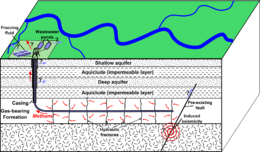The University of Texas at Austin’s Bureau of Economic Geology recently released a new study, entitled the Sloan Foundation Shale Gas Assessment Study, funded by the Alfred P. Sloan Foundation, predicting a reliable, although decreasing, supply of natural gas from the Barnett shale until 2030. Barnett shale is the country’s second most productive shale formation.
This new study is believed to be the most thorough yet on the topic of natural gas production in the Barnett shale, and it predicts a total recovery of over three times cumulative production to date. The study integrated engineering, geology, and economics to do scenario testing. The testers studied the actual data produced from 16,000 wells in the play until 2011. Most other studies of Barnett took a “top down” approach, relying on aggregate views of average production. This study, in contrast, took a “bottom up” approach by studying the production history of every well as well as those areas that remained to be drilled in the future, which they believe yielded a more accurate model. The researchers increased the accuracy of the study by identifying and assessing the production in ten different quality tiers and using that information to predict future production even more accurately. Their new method of estimating production for each well was integral and will contribute to future forecasting of production declines in shale natural gas wells. One of the investigators on the project, Svetlana Ikonnikova, an energy economist at the Bureau, said, “We have created a very dynamic and granular model that accounts for the key geologic, engineering and economic parameters, and this adds significant rigor to the forecasts.”
 The study also demonstrated the correlation between gas prices and production. It noted that in the early years of drilling, the correlation is weak because it is not very expensive to drill in better quality rock areas, making it efficient even when the prices are low. In later years, when the natural gas is harder and more expensive to retrieve, price becomes the dominant factor.
The study also demonstrated the correlation between gas prices and production. It noted that in the early years of drilling, the correlation is weak because it is not very expensive to drill in better quality rock areas, making it efficient even when the prices are low. In later years, when the natural gas is harder and more expensive to retrieve, price becomes the dominant factor.




 DCP and Partners are not the only ones, nor even the most recent, to jump on this bandwagon. In February 2013,
DCP and Partners are not the only ones, nor even the most recent, to jump on this bandwagon. In February 2013, 
 The Eagle Ford has already shown impressive growth, going from 100,000 barrels per day of liquids such as natural gas in early 2011, to 700,000 barrels per day by December 2012. This dramatic increase is, according to WoodMac, due to technology and expertise. A lot of the money spent in the Eagle Ford this year will come from three major operators:
The Eagle Ford has already shown impressive growth, going from 100,000 barrels per day of liquids such as natural gas in early 2011, to 700,000 barrels per day by December 2012. This dramatic increase is, according to WoodMac, due to technology and expertise. A lot of the money spent in the Eagle Ford this year will come from three major operators: